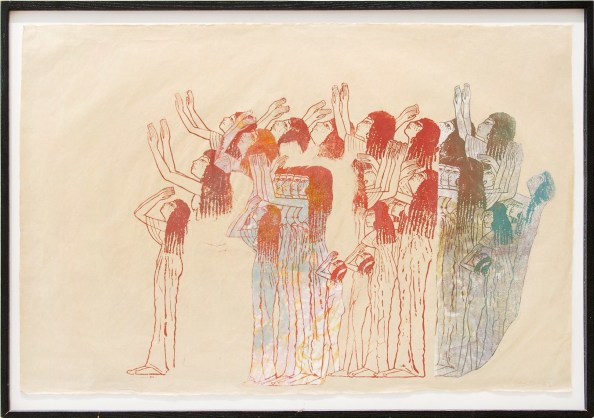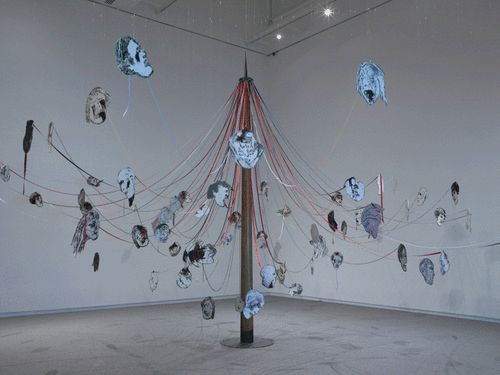

WATERVILLE, Maine — To get to Nancy Spero: Unbound at the Colby College Museum of Art, you have to pass through a stunning show of prints by a formidable line-up of early 20th-century German Expressionists (Self and Society: The Norma Boom Marin Collection of German Expressionist Prints, through January 13). Works like Christian Rohlfs’s 1918 woodcut painted over with gouache, “Tod Als Jongleur” (“Death as a Juggler”), and Max Beckmann’s 1915 drypoint print, “Die Granate” (“The Grenade”), evoking the destructive power of war, prove to be a perfect prelude to the Spero exhibition one floor down.
Spero (1926–2009) often used her art to reflect on the terrors and tragedy of wars, most notably American aggression in Vietnam. This exhibition includes a number of works on paper from The War Series: Bombs and Helicopters (1966–1970), which directly address that conflict. These “single manifestos,” as Spero called them in an interview with art historian Stephanie Buhmann in 2003, were painted “fast and furiously.”
For Spero, the helicopter was a primary symbol of the war. In “Helicopter and Victims” (1967), the aircraft is transformed into a predatory bird, with skulls raining down from its beak and rear. “The helicopter becomes anthropomorphic,” Spero once noted, “a primeval (prime-evil) bird or bug wreaking destruction.” A black-and-white photo of helicopters in the Tay Ninh Province accompanies the piece.
A gouache and ink work from 1966, “River of Victims,” also Vietnam-related, depicts people being swept away; the loosely rendered figures are mixed in with washes of color. More in your face is Spero’s “Phallus Bomb” (1968), an orange-hued missile-prick pointed skyward.
The centerpiece of the show, “Maypole: Take No Prisoners II” (2008) raises — literally — Spero’s antiwar aesthetic to a new level. The artist took a festive symbol of the return of spring and community celebration and turned it into a vehicle of indictment and indignation — and horror. As art critic Jillian Steinhauer put it in a 2017 review, “If a dance occurs around this maypole, it’s one of violence and death.”
The piece is comprised of a mix of colored ribbons (red is prominent) and thin steel chains draped from a central wooden pole, each ending in a cast-aluminum head (its face drawn by Spero) that is held in the air by fishing line attached to the ceiling. The cut-out victim heads, most of them two-sided, scream, weep, gape, stick out tongues, Guernica-like, their features roughly delineated.
Spero had first used the maypole in a Vietnam-related piece, “Kill Commies/Maypole,” from 1967. In an interview for Art 21 on PBS in 2007, the artist described the gouache and ink on paper as “bloody severed heads hanging from gaily-colored ribbons.” She returned to the maypole conceit in response to the Iraq war. As she told art historian Deborah Frizzell in 2003:
Today it’s the same, absolutely the same as it was 40 years ago, only worse. The government hides everything from us today […] The Maypole is full of victims; the blood is coming out of their heads. They’re decapitated […] I responded to the debacle in Iraq as I did during the Vietnam War, by trying to express the obscenity of war.
The visages in “Maypole” are visually and symbolically in sync with some of the grotesque faces in the German Expressionist prints on the floor above, but they also connect to the earlier work in the Spero exhibition. As the artist once explained, the heads were “cannibalized” from some of her Vietnam images. Indeed, the head that appears in “Eagle, Victim, and Pilot,” a gouache, ink, and collage work from 1969–1970, is a clear precedent for some of the skull shapes in “Maypole.”
Spero’s feminism is evident in her “Untitled (This Womb Does Not Belong…)” (1985). The work features small collaged strips of type, arranged telegraph-like, which read: “This womb doesn’t belong to doctors, legislators, politicians, judges, the state, etc.” The pro-reproductive rights message, based on a banner Spero created for an exhibition at the Brooklyn Bridge Anchorage in 1985, is affixed to a figure that resembles a prehistoric cave painting, her limbs and body in the middle of a seemingly joyous, leaping dance.
The “unbound” spirit carries through to other works in the show, including several frieze-like images of goddesses and beseeching women. Two diptychs are of particular interest for their underlying feminist message: “Liberty-Athlete” (1995), which juxtaposes a running female figure with the famous French Revolution image of liberty at the barricades; and “Grey Sheela Diptych” (1987), which features Sheela-Na-Gig, a Celtic goddess of fertility and destruction who appears in some of Spero’s scroll paintings from the 1980s.
Drawing on their remarkable Lunder Collection of old master prints, the Colby curators set up a dialogue between Spero’s work and two of Goya’s famous print series’, Los Disparates (The Follies, 1815-23), which ran through early November and was replaced with additional works by Spero, and Los Caprichos (The Caprices, 1797–98), a bound copy of which is currently displayed in a vitrine. The juxtaposition underscores an essential commonality between the two bodies of work: their ongoing relevance in our times. Goya’s riffs on human foibles continue to ring true, while the issues that compelled Spero to create some her most provocative work never cease to trouble us.
Nancy Spero: Unbound continues at Colby College Museum of Art (5600 Mayflower Hill, Waterville, Maine) through January 20